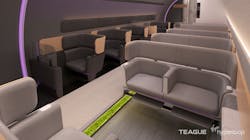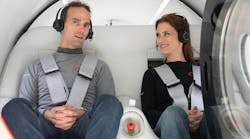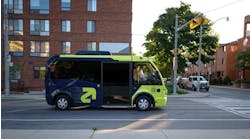Virgin Hyperloop shares what its passenger experience will be like
Virgin Hyperloop unveiled its concept of the passenger experience in a YouTube video on Thursday that the company says speaks to its view of a “greener, smoother, safer and more pleasant mass transit experience.”
The hyperloop journey is viewed as being well lit, sleek with a minimalist design, fast and so smooth, a steaming cup of tea will sit serenely on a ledge while the pod travels at 670 mph.
“Designing a new mode of transportation from scratch is both an opportunity and a responsibility,” said Sara Luchian, Virgin Hyperloop’s director of Passenger Experience and one of the first people to ride the hyperloop in November. “Hyperloop technology – and what it enables – is paradigm-shifting. It follows that the passenger experience should be nothing short of extraordinary.”
The company worked with several partners to design “a comprehensive, multi-sensory passenger experience that surpasses that of any other form of mass transit.”
Teague designed the interior of the pods and, as CEO and President John Barratt explains, the company utilized the best concepts from several industries, such as rail, aviation and hospitality to develop the concept.
“Recessed seat wells provide a greater sense of space, while the raised aisle is a touch of the unexpected and unique. Bands of greenery and wood textures subvert the aesthetic of typical mass transit materials with something optimistic and fresh. All lighting in the pod—including the unassuming information displays—are dynamic and adjust based on traveler activity and journey milestones," said Barratt.
Virgin Hyperloop also considered non-traditional interactions of the transportation experience to enhance, such as sound. The challenge presented by hyperloop, according to Man Made Music Founder and Lead Composer Joel Beckerman, was evoking a sense of privacy and space that enhanced the sense of safety and calm.
“We respond to sound quicker than any other sense, so sound actually drives the multi-sensory experiences. The sonic cues of the Virgin Hyperloop identity system serves as a guide for passengers throughout their experience while instilling confidence, safety and clarity – you ‘feel’ it rather than ‘hear’ it. Just like a great movie score, it tells you the story. We know when we’ve got it right when you don’t notice the sound at all: the interface is humanized in ways that are both fresh and familiar,” said Beckerman.
Virgin Hyperloop notes accessibility is an important part of the passenger experience with CEO Jay Walder summing up the simplicity of the concept: If it’s not affordable, people won’t use it.
“Daily high-speed transport is currently not feasible for most people, but we want to change that notion. Imagine being able to commute between cities that are currently hours apart in minutes – and the endless possibilities that opens up,” said Walder.
A study last year of the proposed hyperloop between Chicago and Columbus estimated a ticket cost of $60 for a 45-minute journey versus a six-hour ride in a car or a $100 plane ticket for the same trip. The time and cost to travel from Columbus and Pittsburgh was estimated to be $33 for a 30-minute ride on hyperloop compared to three hour drive or a $150 plane ticket.
A video walk through of the hyperloop experience can be viewed below.

Mischa Wanek-Libman | Group Editorial Director
Mischa Wanek-Libman is director of communications with Transdev North America. She has more than 20 years of experience working in the transportation industry covering construction projects, engineering challenges, transit and rail operations and best practices.
Wanek-Libman has held top editorial positions at freight rail and public transportation business-to-business publications including as editor-in-chief and editorial director of Mass Transit from 2018-2024. She has been recognized for editorial excellence through her individual work, as well as for collaborative content.
She is an active member of the American Public Transportation Association's Marketing and Communications Committee and served 14 years as a Board Observer on the National Railroad Construction and Maintenance Association (NRC) Board of Directors.
She is a graduate of Drake University in Des Moines, Iowa, where she earned a Bachelor of Arts degree in Journalism and Mass Communication.





